There’s nothing more frustrating than a slow-draining sink or shower caused by a buildup of hair. Over time, loose strands get caught in the pipes, mixing with soap scum and other debris to form a stubborn clog. If left unchecked, these clogs can cause standing water, nasty odors, and even bigger plumbing issues.
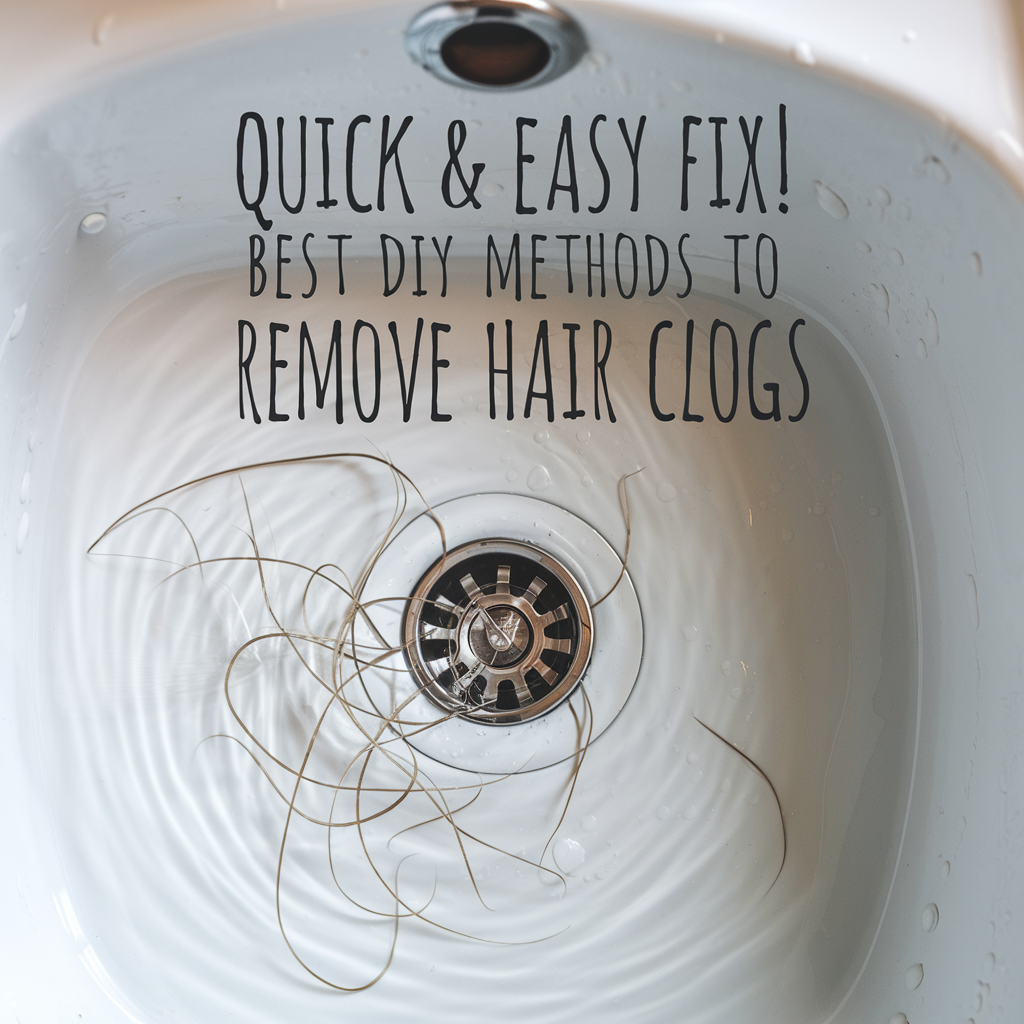
The good news? You don’t need harsh chemicals or a plumber to fix the problem. Learning how to unclog a drain with hair using simple DIY methods can save you time and money. Whether it’s a sink, shower, or bathtub drain, there are plenty of effective, chemical-free ways to get things flowing again.
Before jumping into solutions, let’s break down what actually works to dissolve or remove hair clogs—and what doesn’t.
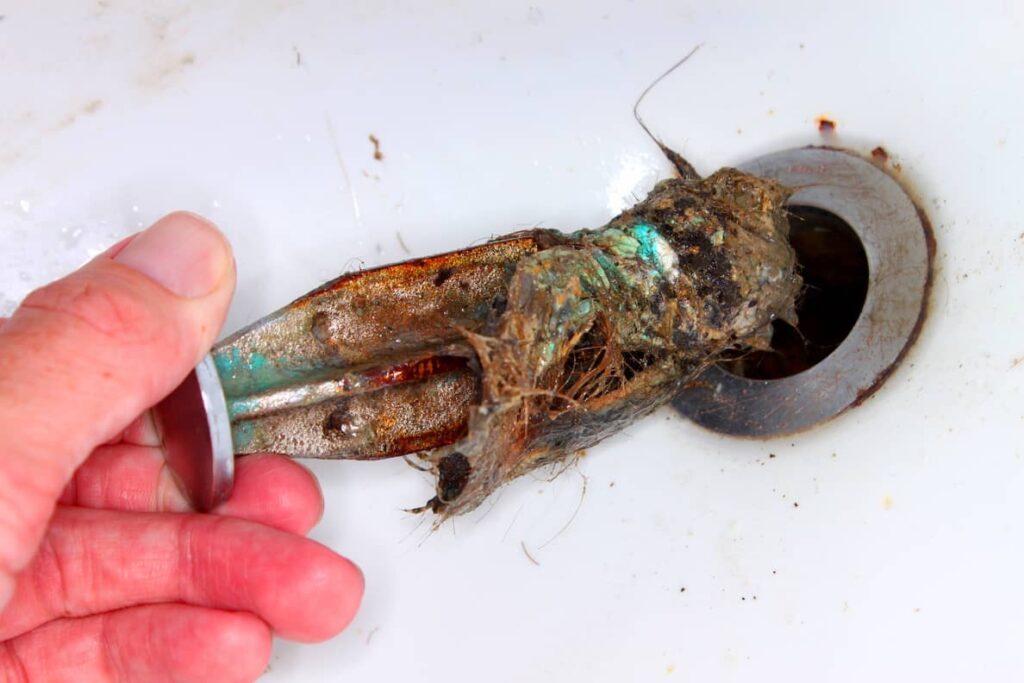
What Will Dissolve Hair in a Drain?
Hair is one of the toughest things to remove from a clogged drain because it tangles around itself, forming a dense blockage. Many homeowners assume chemical drain cleaners are the only solution, but there are safer and more effective ways to dissolve hair without damaging your pipes.
Enzymatic Drain Cleaners: A Natural Solution
Unlike harsh chemical cleaners that rely on lye or acids, enzymatic drain cleaners use bacteria and natural enzymes to break down organic matter like hair and soap scum. These are safer for your pipes and the environment, but they take longer to work—usually a few hours or overnight.
Baking Soda and Vinegar: Does It Really Work?
One of the most popular home remedies for clogged drains is a combination of baking soda and vinegar. While this fizzy reaction can help break down grime, it won’t fully dissolve hair. However, it can loosen buildup enough to make physical removal easier.
Boiling Water: Helpful or Harmful?
Pouring boiling water down the drain can sometimes help loosen hair clogs, especially if soap scum is holding them together. However, this method only works in metal pipes. If you have PVC pipes, boiling water can soften and weaken the plastic over time.
For the fastest results, manual removal is almost always necessary. Let’s look at the quickest ways to get hair out of a clogged drain.
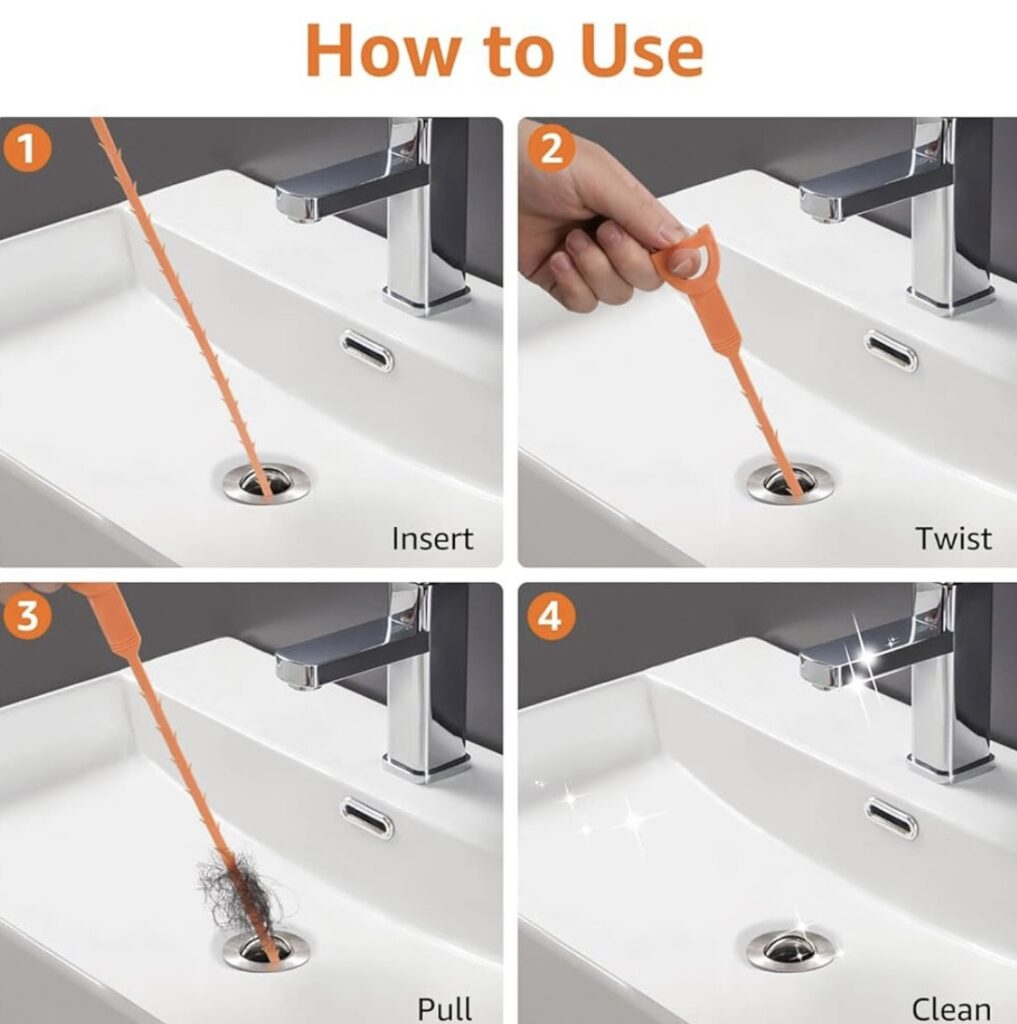
What Is the Fastest Way to Get Hair Out of a Drain?
When dealing with a hair clog, the fastest and most effective method is to physically remove the hair. While some home remedies can loosen the clog, nothing beats pulling the hair out directly. Here are the best tools and techniques to get the job done quickly.
Drain Snakes: The Ultimate Hair Removal Tool
A drain snake (also called a drain auger or hair clog remover) is one of the easiest and most effective tools for unclogging a drain filled with hair. These flexible tools slide into the drain, grab tangled hair, and pull it out.
For a budget-friendly and highly effective option, check out the Amazon Basics Drain Clog Remover Tool, which includes 5 plastic and 1 stainless steel drain snakes designed specifically for hair clogs in sinks, tubs, and showers.
How to use a drain snake:
- Insert the drain snake into the drain opening.
- Twist and push it down until you feel resistance (this is the hair clog).
- Slowly pull it out—expect to see a nasty clump of hair!
- Repeat if necessary until the drain is clear.
Wire Hanger Trick: A DIY Alternative
If you don’t have a drain snake, a simple wire hanger can work in a pinch. Straighten out a hanger, leaving a small hook on one end, and use it to fish out the hair from the drain. This method works best for shallow clogs near the surface.
Wet/Dry Vacuum: Powerful Suction for Stubborn Clogs
A wet/dry shop vacuum can be a surprisingly effective way to pull out hair clogs, especially for deeper blockages. Simply place the vacuum hose over the drain, create a tight seal, and switch it on. The strong suction can dislodge and remove trapped hair quickly.
While these methods can get rid of most hair clogs, some homeowners swear by baking soda and vinegar as a natural alternative. But does it really work? Let’s find out.

Do Baking Soda and Vinegar Really Dissolve Hair?
Baking soda and vinegar is one of the most popular DIY drain-cleaning tricks out there, but when it comes to hair clogs, it has its limitations. While the fizzing reaction helps break down grease and soap scum, it does not fully dissolve hair. However, it can loosen buildup, making it easier to remove the clog with a drain snake or other tool.
How to Use Baking Soda and Vinegar for a Hair Clog
- Pour ½ cup of baking soda directly into the drain.
- Slowly add 1 cup of white vinegar. You’ll hear a fizzing sound as it reacts with the baking soda.
- Let it sit for 15–30 minutes. This gives it time to break down any gunk holding the hair together.
- Flush with hot water (but not boiling water if you have PVC pipes).
When This Method Works (And When It Doesn’t)
✅ Works for mild clogs that are mostly caused by soap scum buildup.
❌ Does not dissolve large hair clumps or deep clogs.
For stubborn hair clogs, baking soda and vinegar can be a helpful step before using a drain snake to physically remove the blockage. If you’re dealing with a serious clog, you may also wonder whether boiling water can do the trick. Let’s break that down next.
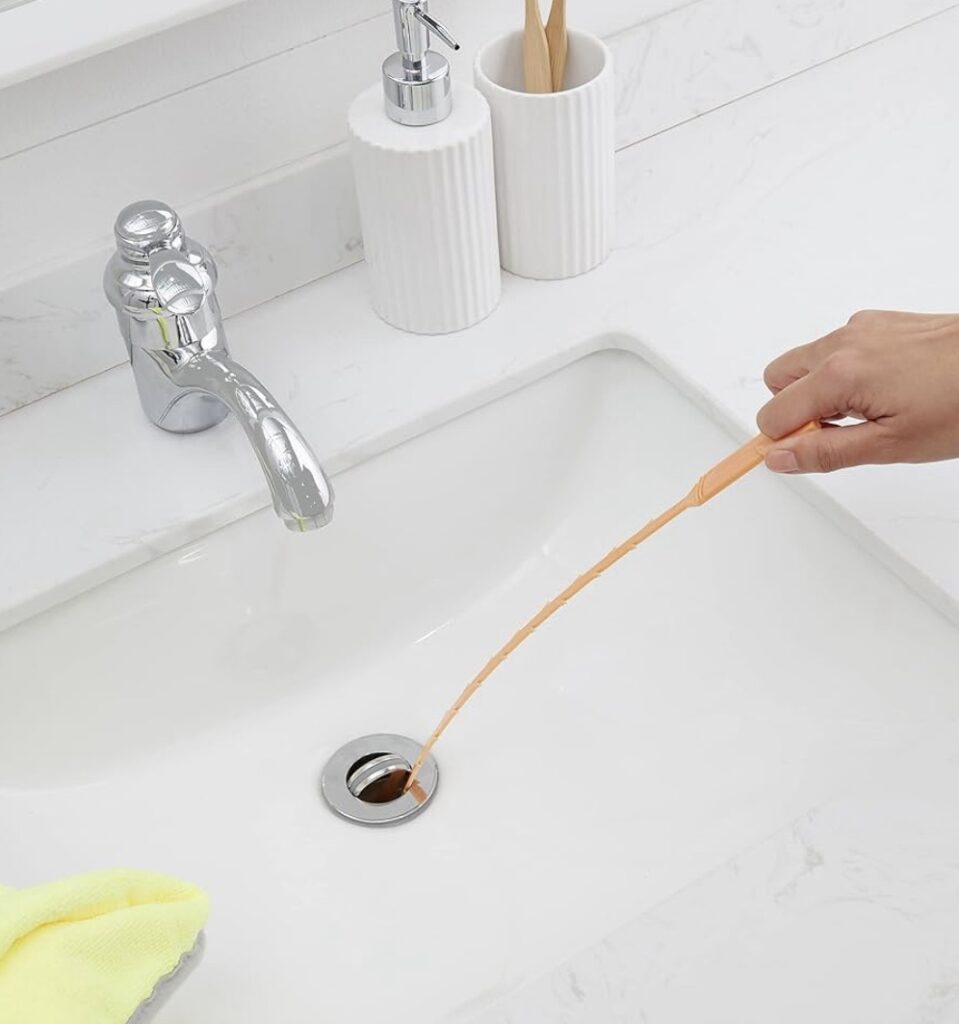
Will Boiling Water Remove Hair From the Drain?
Boiling water is a go-to trick for dissolving grease and soap scum, but when it comes to hair clogs, it’s not always effective. Hair doesn’t break down easily in hot water alone, so while it may loosen some buildup, it won’t completely remove a clog on its own.
When Boiling Water Can Help
- If the clog is caused by soap scum and grease buildup, boiling water can help loosen the blockage so hair is easier to remove.
- Works best in metal pipes (copper, galvanized steel) where high temperatures won’t cause damage.
When You Should NOT Use Boiling Water
- If you have PVC pipes – The extreme heat can soften and warp plastic pipes over time, leading to bigger plumbing issues.
- If the drain is fully blocked – Pouring boiling water onto a clog can cause hot water to back up, potentially damaging your sink or tub.
Better Alternatives for Hair Clogs
Instead of relying on boiling water, use a drain snake like the Amazon Basics Drain Clog Remover Tool or try the baking soda and vinegar method first to loosen buildup. Then follow up with hot (not boiling) water to flush out any remaining debris.
If none of these solutions work, the clog may be deeper in the drain, which means it’s time to take things a step further. Let’s go over how to manually open a drain to clear a tough hair clog.
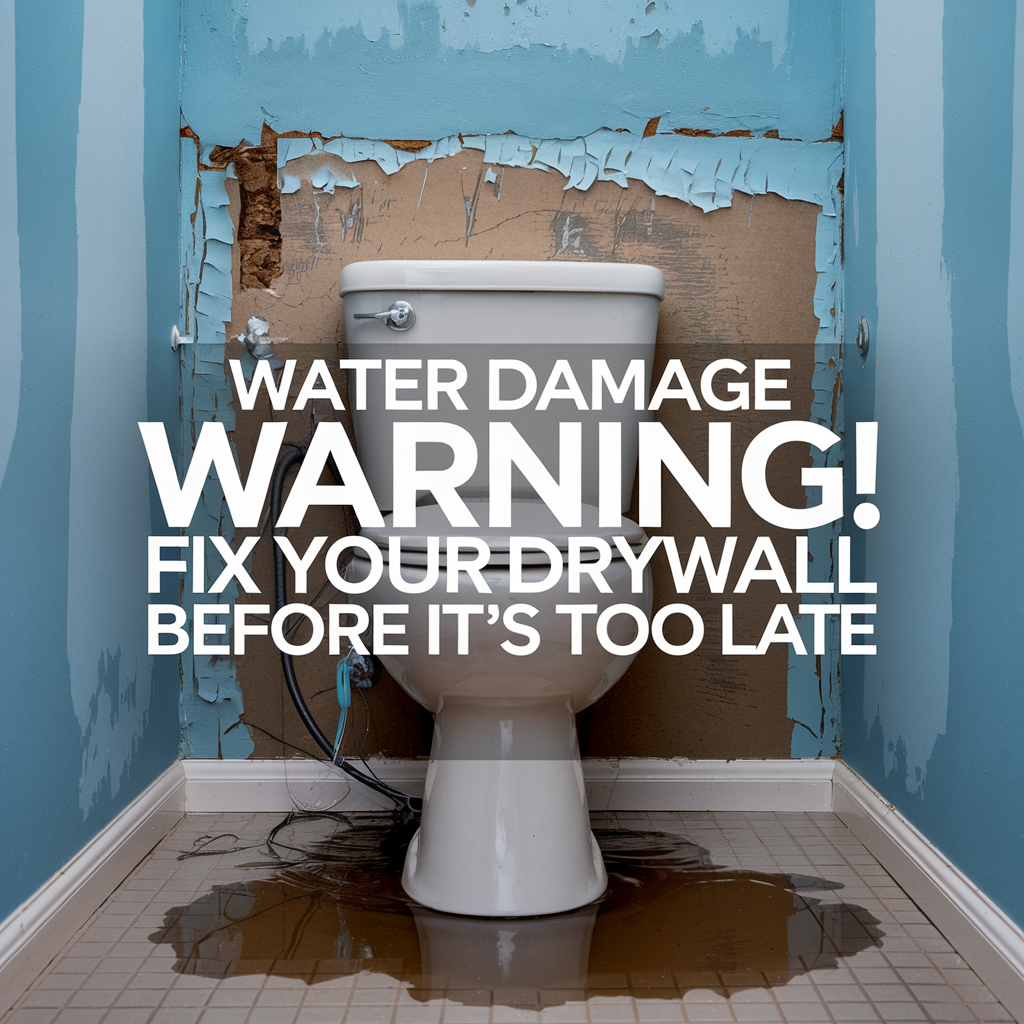
How Do You Open a Clogged Drain With Hair?
If basic DIY methods like baking soda, vinegar, and drain snakes don’t work, the clog might be deeper in the plumbing system. In that case, you’ll need to manually open the drain to remove the blockage.
Step 1: Remove and Clean the Drain Stopper
Many bathroom sinks and tubs have a drain stopper that traps hair before it washes further into the pipes. Over time, these can become clogged with tangled hair and soap scum.
- For a sink drain: Unscrew or pull up the stopper, then clean off any trapped hair.
- For a bathtub drain: Use pliers to twist and lift the stopper out, then remove the debris.
This simple fix can immediately improve slow drainage. But if water is still backing up, the clog is deeper.
Step 2: Clear the P-Trap (For Sink Drains)
A P-trap is the curved pipe under your sink that collects debris before it moves into the main drain line. If the clog is in this section, you’ll need to open it up.
- Place a bucket under the P-trap to catch any water.
- Unscrew the slip nuts on both ends of the trap using a wrench or your hands.
- Remove the trap and clean it out. Look for trapped hair and gunk, then rinse it out.
- Reattach the P-trap and run water to see if the clog is gone.
For a deeper look at why P-traps get clogged and how to prevent it, check out Understanding Clogged P-Traps: Causes, Fixes, and Prevention.
Step 3: Check for a Clogged Sewer Vent Pipe
If you’ve tried everything and multiple drains in your home are slow or backing up, the issue could be with your sewer vent. When vent pipes get clogged (often with debris, nests, or leaves), it creates a vacuum effect that slows down drainage.
To learn more about signs of a clogged vent pipe and how to fix it, read Clogged Sewer Vent Pipe Symptoms, Fixes, and Prevention.
If none of these steps clear the clog, it’s time to prevent future hair buildup before it becomes a bigger issue. Let’s go over the best ways to keep your drains clear.
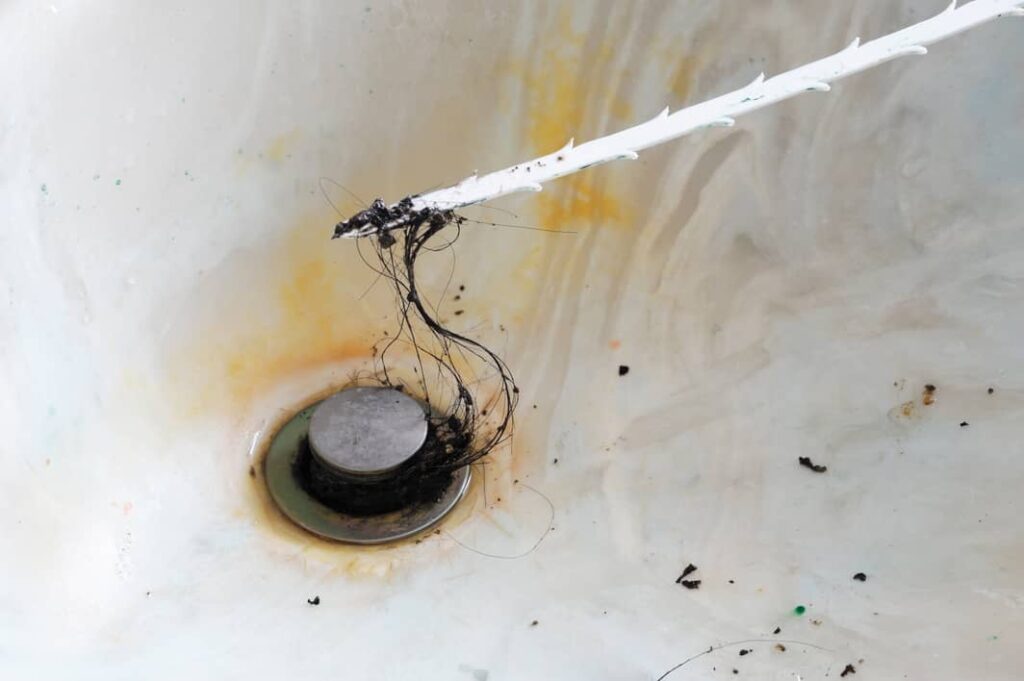
How to Prevent Hair Clogs in Drains
Unclogging a drain full of hair is frustrating, so the best solution is to prevent hair from getting stuck in the first place. A few simple habits and inexpensive tools can keep your drains flowing freely and save you from constant maintenance.
Use a Drain Cover or Hair Catcher
A hair catcher is one of the easiest ways to stop hair from clogging your pipes. These simple mesh or silicone screens sit over your drain, trapping hair before it goes down.
- For sinks and tubs – Use a fine mesh drain cover to catch hair before it enters the drain.
- For showers – A pop-up hair catcher is great for collecting strands while allowing water to flow through.
Cleaning your drain cover regularly prevents buildup and keeps water draining smoothly.
Brush Your Hair Before Showering
Loose strands naturally shed while washing your hair. Brushing your hair before a shower helps catch the majority of loose strands, reducing the amount that ends up in your drain.
Flush Drains With Hot Water Weekly
Running hot (not boiling) water down your drains once a week helps prevent soap scum and hair from forming stubborn blockages.
- For metal pipes, use very hot water to dissolve any buildup.
- For PVC pipes, use moderately hot water to avoid damaging the plastic.
Clean Your Drain Monthly With Baking Soda and Vinegar
While this method isn’t strong enough for fully clogged drains, it helps prevent hair and gunk from sticking inside the pipes.
- Pour ½ cup of baking soda into the drain.
- Add 1 cup of vinegar and let it fizz for 15 minutes.
- Flush with hot water to wash away any loose debris.
Avoid Pouring Grease and Soap Residue Down the Drain
Grease, conditioner, and soap scum can create a sticky coating inside pipes, trapping hair and leading to major clogs. Never pour grease down the drain—instead, check out The Hidden Dangers of Pouring Grease Down the Drain to see why it’s such a bad idea.
Schedule Regular Deep Cleanings
If you deal with frequent clogs, consider snaking your drains every few months as a proactive measure. Investing in a reusable Amazon Basics Drain Clog Remover Tool makes this process quick and easy.
By following these simple steps, you can prevent hair clogs before they turn into a major headache. If you’re dealing with additional plumbing issues, check out DIY Plumbing Repairs Made Easy for more solutions.
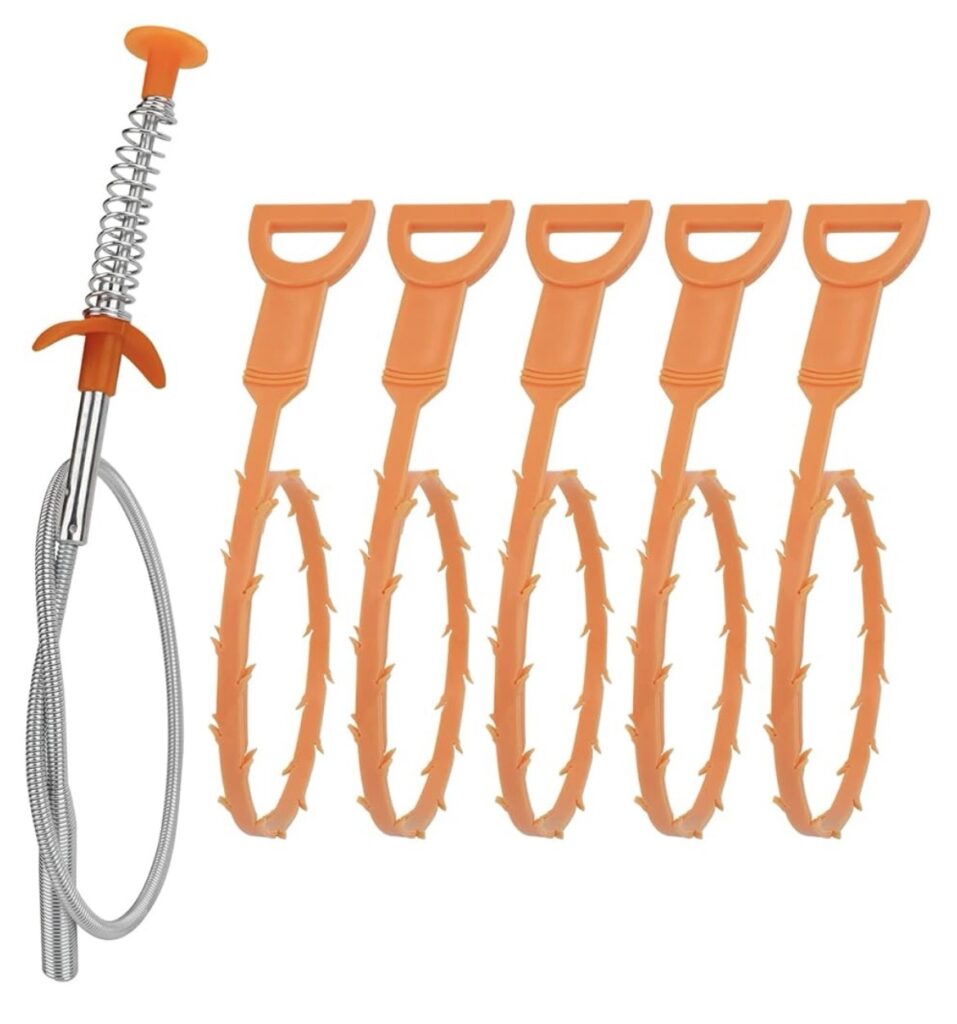
Related DIY Plumbing Fixes and Drain Maintenance
Hair clogs aren’t the only issue that can slow down your drains. Plumbing problems often start small but can quickly escalate into costly repairs if left unchecked. If you’re dealing with slow drains, bad odors, or recurring clogs, these DIY guides can help you identify and fix common plumbing issues before they get worse.
Other Drain and Plumbing Issues You Should Watch For
Sewer Vent Blockages Can Mimic a Hair Clog
Sometimes, slow drains aren’t caused by hair buildup but by a clogged sewer vent pipe. When these vents get blocked by debris, birds’ nests, or ice, they prevent air from flowing properly, creating a vacuum that slows drainage. If your drains gurgle or you smell sewer gas, you might have a vent issue. Learn how to fix it in Clogged Sewer Vent Pipe Symptoms, Fixes, and Prevention.
P-Traps Can Also Get Clogged
P-traps are designed to hold water and prevent sewer gases from rising into your home, but they can also trap hair, grease, and other debris. If your sink drain is slow and you’ve already removed surface hair, the issue could be in the P-trap. Here’s how to fix it: Understanding Clogged P-Traps: Causes, Fixes, and Prevention.
Foul Odors Coming From the Drain?
Hair clogs often trap bacteria, leading to nasty smells coming from your sink or shower. But sometimes, the issue is deeper, especially if your bathroom still smells even after clearing the drain. If that’s the case, check out No More Odors! Transform Your Bathroom With This Simple Urine Smell Removal Trick.
Frozen Pipes Can Lead to Slow Drains and Bigger Problems
In colder months, frozen pipes can slow or completely block drainage. If you suspect freezing is affecting your plumbing, you’ll want to act fast to prevent bursting. Learn how to thaw frozen pipes safely in How to Thaw Frozen Pipes Underground or What to Do With Frozen Pipes: Tips to Prevent Damage.
Don’t Forget Regular Plumbing Maintenance
Preventative maintenance is the best way to avoid major plumbing headaches. If you want to keep your drains running smoothly and avoid expensive repairs, check out DIY Plumbing Repairs Made Easy.
By understanding the root causes of slow drains and keeping up with maintenance, you can prevent clogs, avoid unnecessary repairs, and keep your plumbing in top shape.

Final Thoughts For Now On Removing Hair Stuck In Your Drains!
Dealing with a drain clogged by hair is frustrating, but with the right approach, you don’t need harsh chemicals or a plumber to fix it. Whether you’re dealing with a slow sink or a backed-up shower, simple tools like a drain snake, the Amazon Basics Drain Clog Remover Tool, or even a wire hanger can quickly remove the blockage.
While methods like baking soda and vinegar or boiling water can help loosen buildup, they won’t fully dissolve hair. Physical removal is always the fastest and most effective way to clear a hair clog. If the clog is deeper in the plumbing, checking the P-trap or even your sewer vent pipe may be necessary.
The best way to avoid this hassle in the future? Prevent hair from going down the drain in the first place. Using a hair catcher, regularly flushing your drains with hot water, and cleaning your drain stopper can keep your pipes clear.
If you’re facing other plumbing issues like slow drains, sewer smells, or frozen pipes, be sure to check out:
- Clogged Sewer Vent Pipe Symptoms, Fixes, and Prevention
- Understanding Clogged P-Traps: Causes, Fixes, and Prevention
- DIY Plumbing Repairs Made Easy
With the right tools and know-how, you can tackle hair clogs quickly, prevent future blockages, and keep your drains running smoothly.
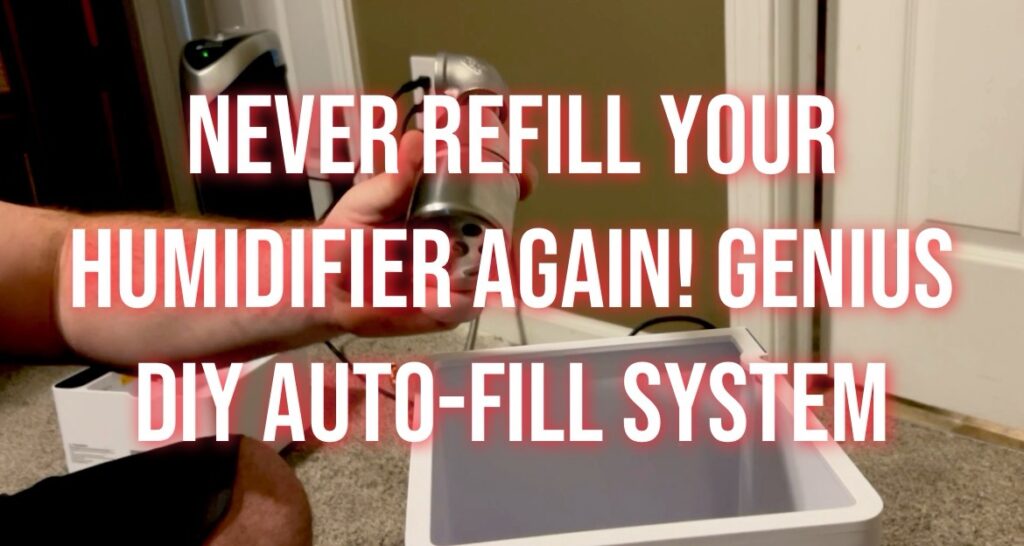
As an Amazon Associate we earn from qualifying purchases through some links in our articles.



